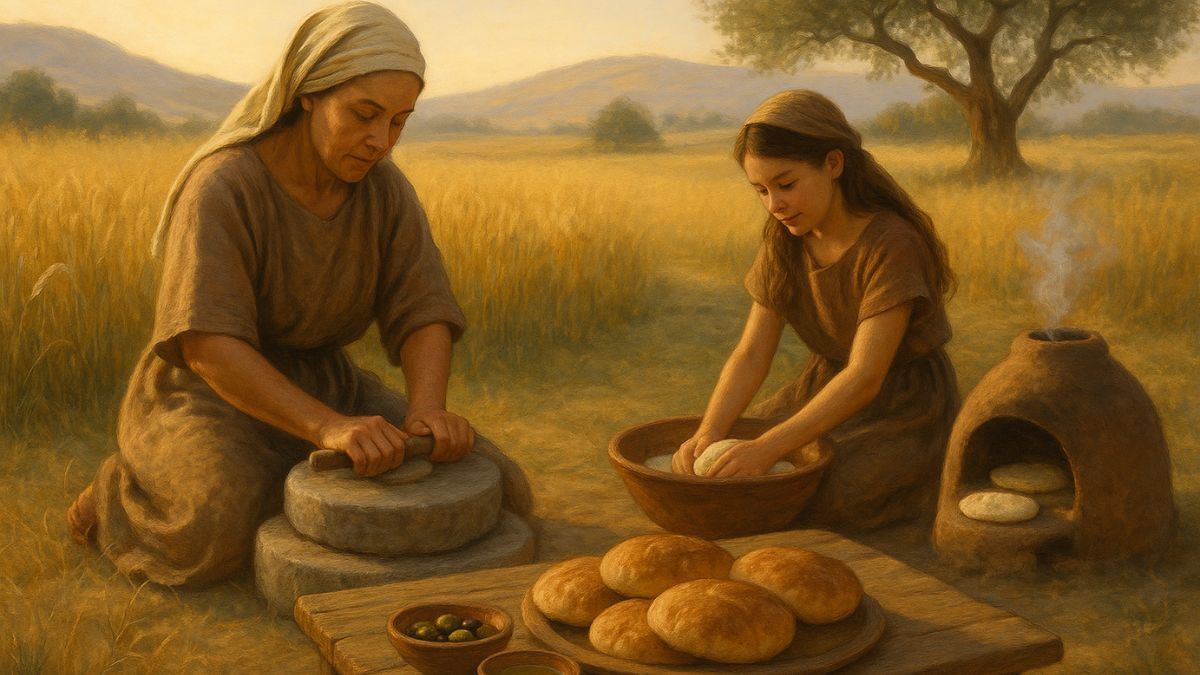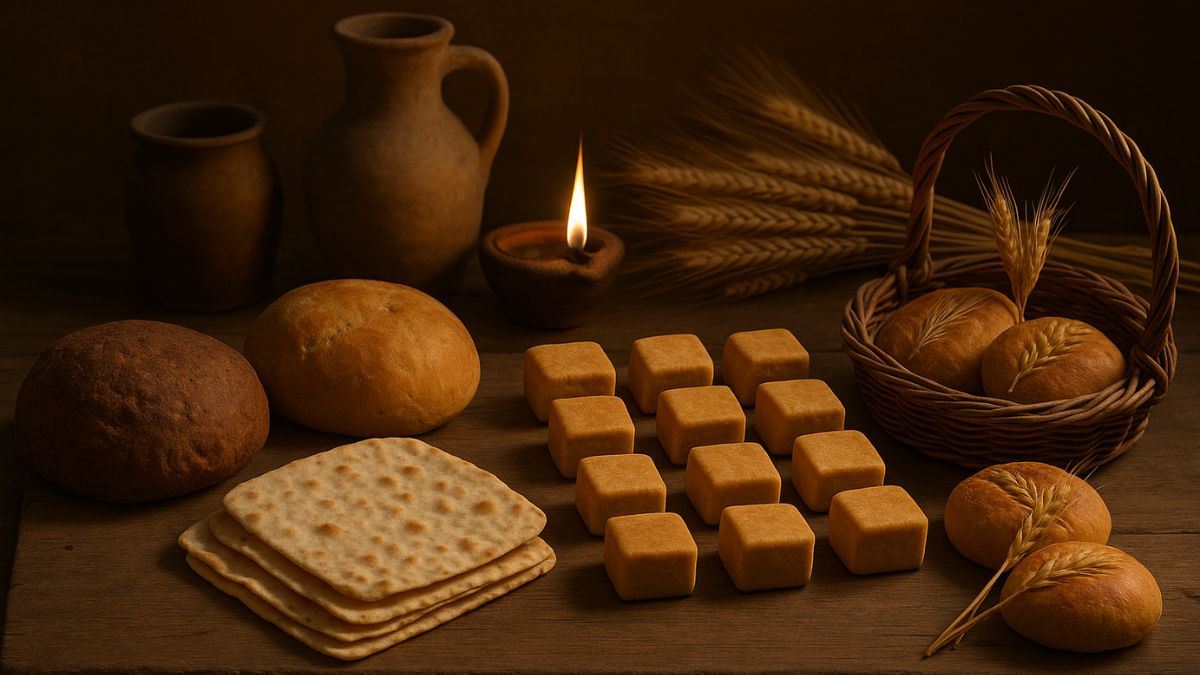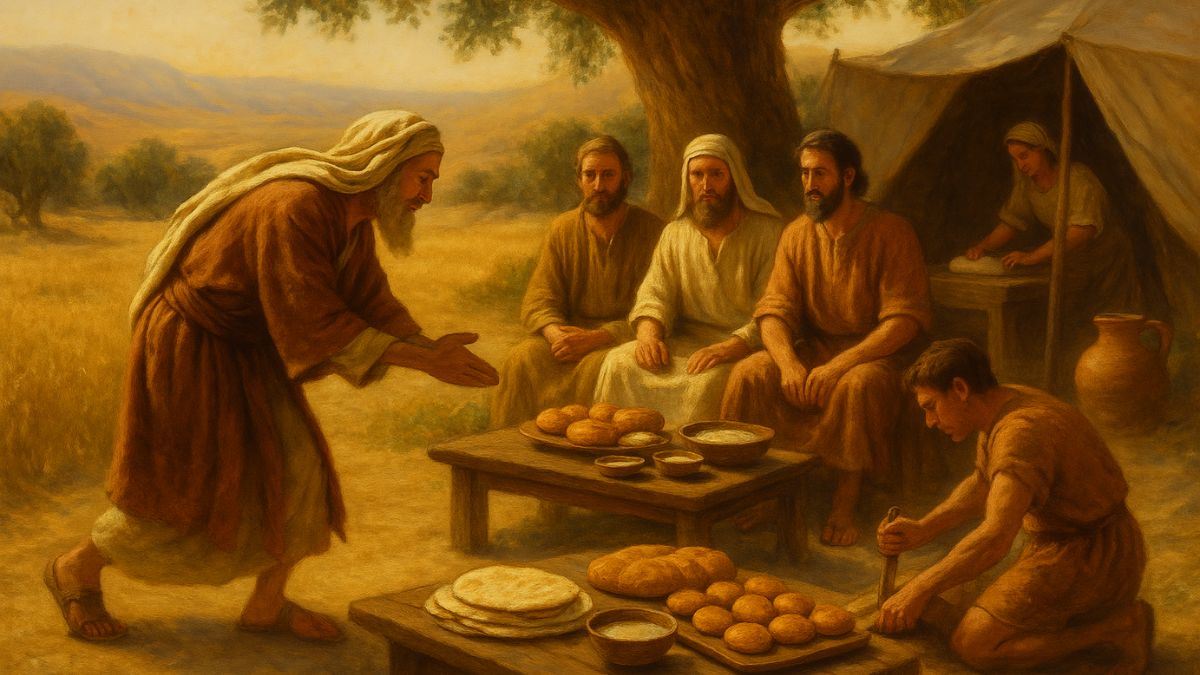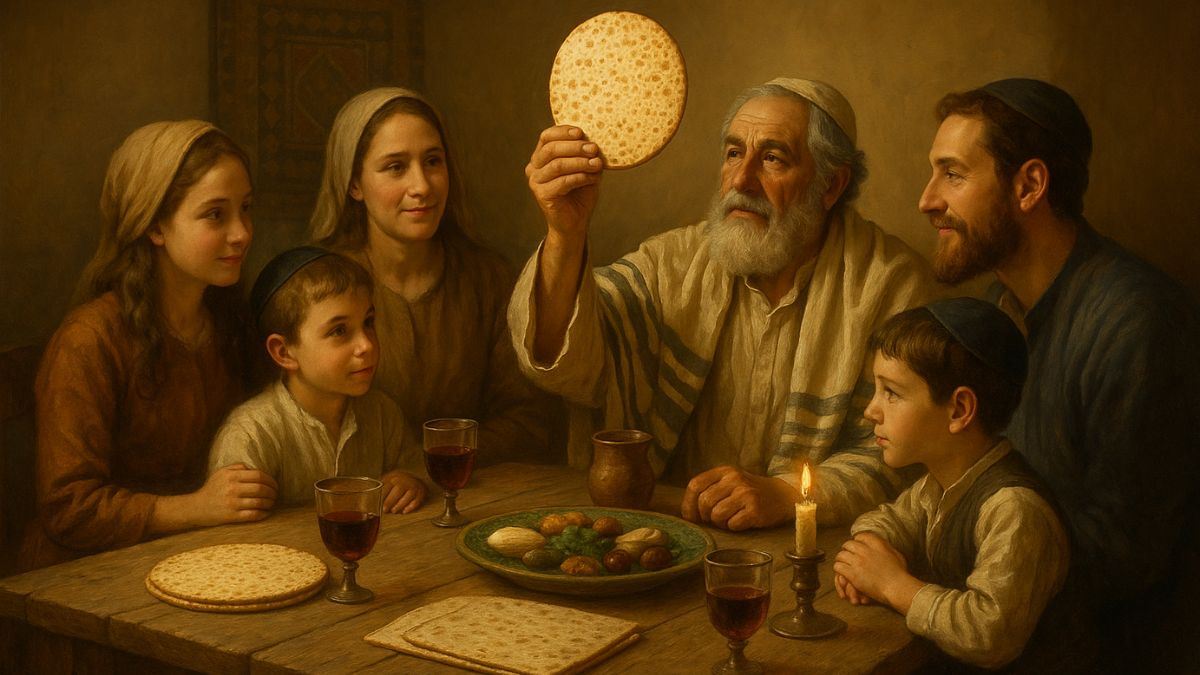The Importance of Bread in Biblical Times
The Staff of Life in Ancient Israel
In biblical times, bread wasn't just food – it was life itself. As the fundamental component of the daily diet, bread provided most of the calories and energy needed for survival. The Hebrew words for "bread" (לחם/lechem) and "food" were virtually synonymous, to the extent that the phrase "to eat bread" simply meant "to eat."

Beyond its nutritional value, bread was a powerful cultural and religious symbol in ancient Hebrew society, representing divine blessing, the fruit of human labor, and the deep connection between community and land. In the biblical world, the bread - making process – from sowing wheat, through harvesting, grinding, kneading, and baking – was central to daily life and interwoven with religious ceremonies, holidays, and foundational stories of the Hebrew Bible.
Bread in the Bible - Historical Context
Bread appears hundreds of times throughout the Hebrew Bible, underscoring its fundamental importance in ancient Israelite society. When God tells Adam, "By the sweat of your brow you will eat your bread" (Genesis 3:19), it establishes bread as the reward of human labor and the basic necessity of life.
The agricultural rhythm of ancient Israel revolved around grain cultivation, primarily wheat and barley, which formed the backbone of the economy. Archaeological findings reveal that homes typically featured grinding stones and ovens, indicating that bread - making was a universal household activity.
In times of famine or drought, bread scarcity represented the most immediate threat to survival. This explains why many pivotal biblical narratives - from Joseph's management of Egypt's grain supplies to Ruth gleaning in Boaz's fields - center around access to grain and bread. The provision of bread was seen as direct evidence of divine favor, while its absence signaled divine displeasure or punishment.
Types of Bread in The Bible
Barley Bread - The Common People's Sustenance
Barley bread was the staple of ordinary Israelites, particularly the poor. Harvested earlier than wheat and more resistant to harsh growing conditions, barley provided reliable sustenance even in difficult years. In the story of Gideon, the Midianite's dream of a "loaf of barley bread" symbolized the common Israelite who would defeat their army (Judges 7:13).
Wheat Bread - The Preferred Choice
Wheat bread, with its lighter texture and milder flavor, was considered superior to barley bread and was preferred whenever affordable. The finest wheat bread, made from carefully sifted flour, was typically reserved for the wealthy or for special occasions. This "choice flour" (סולת/solet) is referenced numerous times in the Bible, particularly in offerings and when honoring guests. Abraham instructed Sarah to prepare bread from "fine flour" when entertaining the three visitors (Genesis 18:6).
Unleavened Bread - Simplicity and Haste
Unleavened bread (מצה/matzah) features prominently in biblical narratives and ritual. Made simply from flour and water without time to rise, it represented both haste and simplicity. Its most famous appearance is in the Exodus story, where the Israelites fled Egypt with dough that had no time to rise. The resulting unleavened bread became central to Passover observance, commemorating both the haste of departure and the bread of affliction eaten during slavery.
Ceremonial and Special Occasion Breads
Various special breads appear throughout the Bible for specific occasions. The showbread (לחם הפנים/lechem hapanim), twelve loaves arranged in the Tabernacle and later the Temple, represented the twelve tribes of Israel before God. First fruits offerings included breads made from newly harvested grain.

Bread in Biblical Worship and Rituals
The Showbread: Bread of the Presence
Perhaps the most sacred form of bread in ancient Israelite worship was the showbread (literally "bread of the face/presence"). Each Sabbath, twelve fresh loaves were placed on a golden table in the sanctuary, representing the twelve tribes of Israel standing in God's presence. After a week, the previous loaves were removed and eaten by the priests in a holy place.
The detailed specifications for the showbread (Leviticus 24:5 - 9) indicate its importance: each loaf required two - tenths of an ephah of fine flour, arranged in two rows of six, with pure frankincense placed upon each row. This bread remained before God continuously, an "everlasting covenant" that maintained Israel's connection to the divine.
Bread in Offerings and Sacrifices
Bread featured prominently in the complex system of offerings described in Levitical law. The grain offering (מנחה/mincha) often included unleavened cakes or wafers mixed with oil. The peace offering could include both leavened and unleavened bread. First fruits celebrations required bread made from new grain, symbolizing the cycle of agricultural renewal and divine provision.
Unleavened Bread in Passover
The seven - day Festival of Unleavened Bread, centered around Passover, enshrined bread as a primary symbol of Israelite identity and historical memory. The command to remove all leaven from homes and eat only unleavened bread created a visceral connection to the Exodus experience - the formative moment when Israel became a nation. This ritual transformed everyday bread into a vehicle for collective memory.
Bread in Key Biblical Stories
Abraham's Hospitality and Bread
When Abraham welcomed three mysterious visitors beneath the terebinths of Mamre (Genesis 18), his first act of hospitality was to offer bread. He instructed Sarah to quickly prepare "three seahs of choice flour" (an abundant amount), demonstrating both his generosity and the central role of bread in hospitality rituals.

Manna in the Wilderness: Bread from Heaven
When the Israelites faced starvation in the wilderness, God provided manna - a mysterious substance described as "thin flakes like frost" that could be gathered and prepared like bread. This "bread from heaven" (Exodus 16) sustained the Israelites throughout their forty - year journey.
The manna narrative established several enduring concepts in Jewish thought: God's direct provision in times of need, the importance of taking only what is needed, and the spiritual lesson that "man does not live by bread alone, but by everything that proceeds from the mouth of the LORD" (Deuteronomy 8:3).
Elijah and the Widow's Flour
During a severe drought, the prophet Elijah encountered a widow preparing to make her last bread before she and her son would die of starvation (1 Kings 17). Elijah's promise that "the jar of flour will not be used up and the jug of oil will not run dry" until rain returned represents one of the Bible's most poignant bread miracles. This story illustrates how bread represented the margin between life and death in ancient societies.
Bread as Metaphor and Symbol in the Bible
"Bread of Affliction" - Hardship and Memory
Matzah is explicitly called "the bread of affliction" (לחם עוני/lechem oni) in Deuteronomy 16:3, establishing bread as a symbol of historical suffering. This metaphor captures how food carries memory - the simple, hastily made bread connects each generation to the experience of slavery and liberation.

Bread as Divine Provision
Throughout the Hebrew Bible, bread frequently symbolizes God's provision and sustenance. In Psalm 104:14 - 15, God is praised as the one who "brings forth bread from the earth." The prophet Isaiah uses bread as a metaphor for divine abundance: "Give bread to the hungry" (Isaiah 58:7) becomes both literal instruction and symbol of righteous action.
Bread in Famous Biblical Verses
Some of the Bible's most memorable passages feature bread as their central image. When the Psalmist writes, "I have been young, and now am old, yet I have not seen the righteous forsaken or their children begging for bread" (Psalm 37:25), bread represents basic social welfare and divine protection.
Archaeological Findings Related to Biblical Bread
Ancient Ovens and Baking Facilities
Archaeological excavations throughout Israel have uncovered numerous bread - making installations that illuminate biblical descriptions. The typical Israelite oven (תנור/tanur) was a clay structure, often bell - shaped, where dough would be slapped against the interior walls to bake. These ovens appear in virtually every excavated domestic setting, confirming bread's central role in daily life.
More elaborate bread - making facilities have been discovered in larger settlements, with evidence of communal baking areas where multiple families might bring their dough. Palace bakeries in Samaria feature specialized equipment suggesting large - scale bread production for elite households.
Ancient Tools of the Trade
The archaeological record provides tangible connections to biblical bread - making. Hand grindstones (רחיים/rechayim) mentioned in Deuteronomy 24:6 appear abundantly in excavations, often showing substantial wear from daily use. Sieves, kneading troughs, and storage jars specifically designed for grain and flour complement these findings.
Written Records
Written records provide valuable context. Administrative tablets from the ancient Near East record bread distribution, lending context to biblical systems of tribute and support for Temple personnel. Records from the Second Temple period detail the preparation of showbread and other ritual loaves, bridging the gap between biblical prescription and historical practice.
Experience Biblical Bread Making Today
Recreating Authentic Biblical Bread
Modern archaeological science, combined with ancient techniques preserved in traditional communities, allows us to recreate biblical bread with remarkable authenticity. The varieties of wheat grown in Israel today include strains genetically similar to ancient varieties, providing flavors and textures that would be familiar to our ancestors.
The process begins with traditional grain cultivation - sowing, harvesting, and threshing using methods that have changed little over millennia. Hand grinding with stone mills produces flour with distinctive characteristics impossible to achieve with modern steel mills. Baking in clay ovens recreates not just the flavors but the unique textures of biblical bread - the distinctive char patterns and the smoky aroma that permeated ancient households each morning.
Educational Value of Ancient Bread - Making
Experiencing biblical bread - making provides unique educational insights impossible to gain from texts alone. The physical labor of grinding grain helps modern visitors understand why daily bread required such significant household investment. The distinctive rhythm of bread preparation - mixing dough in the evening, baking in the morning - illuminates the timing of biblical narratives and the structure of ancient daily life.
For students of the Bible, these experiences transform abstract references into visceral understanding. The effort required to produce even a small quantity of bread clarifies why bread was so precious, why gleaning laws were so important, and why bread features so prominently in biblical ethics.
From Wheat to Bread: The Complete Biblical Experience at Kfar Kedem
At Kfar Kedem, visitors can journey through the complete biblical bread - making process, from wheat field to fresh - baked loaf. Begin by harvesting wheat with traditional sickles in our fields, then thresh the grain using ancient methods. Take your turn at the grinding stones to transform wheat kernels into flour, feeling the effort that went into every biblical meal.
Mix your dough with pure water, learning the techniques that have been passed down through generations. Shape your loaf by hand and experience the satisfaction of watching it bake in our clay ovens, built according to archaeological models. Finally, break bread together as our ancestors did, tasting history in every bite and understanding scripture in a new, more tangible way.
This immersive experience brings biblical references to life, creates meaningful connections to our heritage, and provides insights into ancient wisdom about sustainability, community, and the sacred nature of daily sustenance.
Bread as a Window to Understanding Biblical Life
Few elements of material culture offer such a direct connection to biblical life as bread. From the fields where grain was grown to the tables where bread was shared, the entire bread - making process embodied the rhythms, values, and challenges of ancient Israel. Bread production shaped daily schedules, determined economic relationships, and provided the language for spiritual concepts that remain powerful today.
The bread traditions established in biblical times have shown remarkable persistence. The unleavened bread of Passover creates a direct sensory link between modern observers and the Exodus experience. Traditional breads in Middle Eastern Jewish communities preserve techniques and flavors that would be recognizable to biblical figures.
Understanding biblical bread opens new dimensions for interpreting scripture. References that might seem incidental reveal deeper significance when we recognize bread's central place in ancient life. Metaphors comparing spiritual truths to bread resonate more powerfully when we appreciate bread's fundamental importance to survival and community.
Experience the Biblical Bread Journey at Kfar Kedem
We invite you to step beyond reading about biblical bread and experience it firsthand at Kfar Kedem. Our authentic Biblical Bread activity offers visitors of all ages the opportunity to participate in every step of the ancient bread - making process. From harvesting wheat in our traditional fields to grinding grain on biblical - style millstones, from kneading dough with your own hands to baking in our clay ovens, you'll connect with the daily reality of our ancestors.
This hands - on experience brings biblical stories to vibrant life, creating memories and insights that reading alone cannot provide. Whether you're interested in biblical history, ancient foodways, or Jewish heritage, our Biblical Bread activity offers a unique window into the world of the Bible.
Visit us at Kfar Kedem to reserve your place in this timeless tradition. Discover why bread was not just food in biblical times but the very staff of life - and taste the connection between past and present in every bite you break with your own hands.